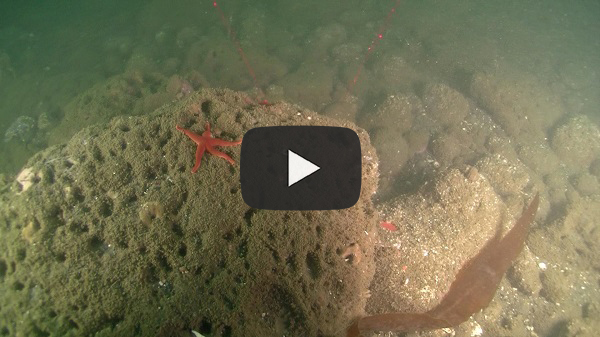Exploring ROV Video Data:
Learning About Subtidal Sea Stars Post Wasting
Though our fall ROV (Remotely Operated Vehicle) video survey for Cascade Head was canceled due to the COVID-19 pandemic, ODFW has been busy analyzing ROV data from previous sampling years.
Effects of Wasting Disease Went Far Beyond Ochre Stars
We’ve described the dramatic changes observed in intertidal ochre star (Pisaster ochraceus) populations associated with the sea star wasting disease outbreak that hit Oregon in 2014. Our latest efforts are now focusing on exploring changes in the abundance of 11 sea star species that live subtidally (i.e. underwater, below the low tide mark) in the Redfish Rocks Marine Reserve.
ROV surveys conducted in 2010, pre-sea star wasting disease, and 2016, post-sea star wasting disease, are showing that five species have drastic declines in total individuals observed per transect surveyed: (1) pink stars (Pisaster brevispinus), (2) sunflower stars (Pycnopodia helianthoides), (3) rainbow stars (Orthasterias koehleri), and the two sun stars (4) Solaster stimpsoni and (5) S. dawsoni. These observations hold true not only at the Redfish Rocks Marine Reserve but also outside of the reserve, at the comparison areas of Orford Reef and Humbug.
Not All Species Showed Drastic Declines
For example, the blood star (Henricia spp.) appears to have increased across all sites whereas observations of the sand star (Luidia foliolata) do not appear to have changed between 2010 and 2016.

ROV is the Go-to Tool for
Bottom-Dwelling Invertebrates
Marine reserve ROV video surveys provide valuable data on the impact of sea star wasting for a wide range of rarely studied sea star species and other bottom-dwelling invertebrates. Many of these species live in deep habitats that can only be surveyed effectively with the ROV. In addition, the sheer amount of video data that the ROV can gather makes it the go-to tool for understanding seafloor invertebrate communities.
 Click to watch video: ROV footage at Redfish Rocks
Though there are numerous reports available on sea star wasting and its impact on the ochre star, Pisaster ochraceous, or on the sunflower star, Pycnopodia helianthoides, there are relatively few on how wasting disease has impacted other subtidal sea star species. We are in the process of exploring changes seen in our marine reserve ROV surveys at Redfish Rocks and comparing them with changes observed in our past surveys at Cascade Head and Cape Perpetua. These three reserves have rocky reef habitat located in deep water that are surveyed with the ROV. The reserves at Otter Rock and Cape Falcon have rocky reef habitat too shallow for ROV surveys. Invertebrate data in these latter two reserves come from less-efficient SCUBA and video lander surveys.
ROV surveys have the added benefit of providing a permanent video record that can be referenced at any point in the future. As a core part of ODFW’s continued, long-term marine reserves monitoring, ROV surveys will continue to expand our understanding of how various sea stars species and other invertebrates respond, recover or adapt to changing environmental conditions over time.

Poachers Caught Setting Stolen Crab Pots
in Marine Reserve Await Trial

Two men caught setting stolen crab pots in Cape Falcon Marine Reserve await trial following a joint effort of citizen reporting and solid detective work.
A Fisherman and Researcher Spot Something Suspicious
Bob Browning has fished Oregon waters all his life. He started fishing off the Garibaldi dock with his family when he was five years old. When he saw a strange object bobbing on the ocean surface, he pointed it out to his client, Dr. Sarah Henkel. Henkel, a researcher with Oregon State University, was collecting data for her latest project studying Dungeness crab. She had hired Browning and his vessel, F/V The Lady Lee, on April 3, 2019 to take her out to the Cape Falcon Marine Reserve for the research project.
Henkel squinted to get a better look. It wasn’t a bird. Even through binoculars, neither the researcher nor the boat captain could identify the small black thing bobbing on the water’s surface. It definitely didn’t look like the bright orange and white surface buoys that marked her research beacons. Browning steered The Lady Lee in for a closer look.
Browning reached down and pulled at the object. It was a black bait bag, about the size of his fist. Inside were two pieces of foam to keep it afloat. But when he tried to pick it up, there was resistance. And a long cord. Browning threaded the rope through his hydraulic lift and started the motor. When a crab pot broke the surface of the water, they knew there was trouble. The line continued. Another crab pot rose from the depths. They reached for their phones to report it.
The Investigation, a Break in the Case, and an Indictment
Read on to find about the ensuing investigation by Oregon State Police, what led to a break in the case, and the recent indictment of two men.

Explore More Marine Reserves News

|









